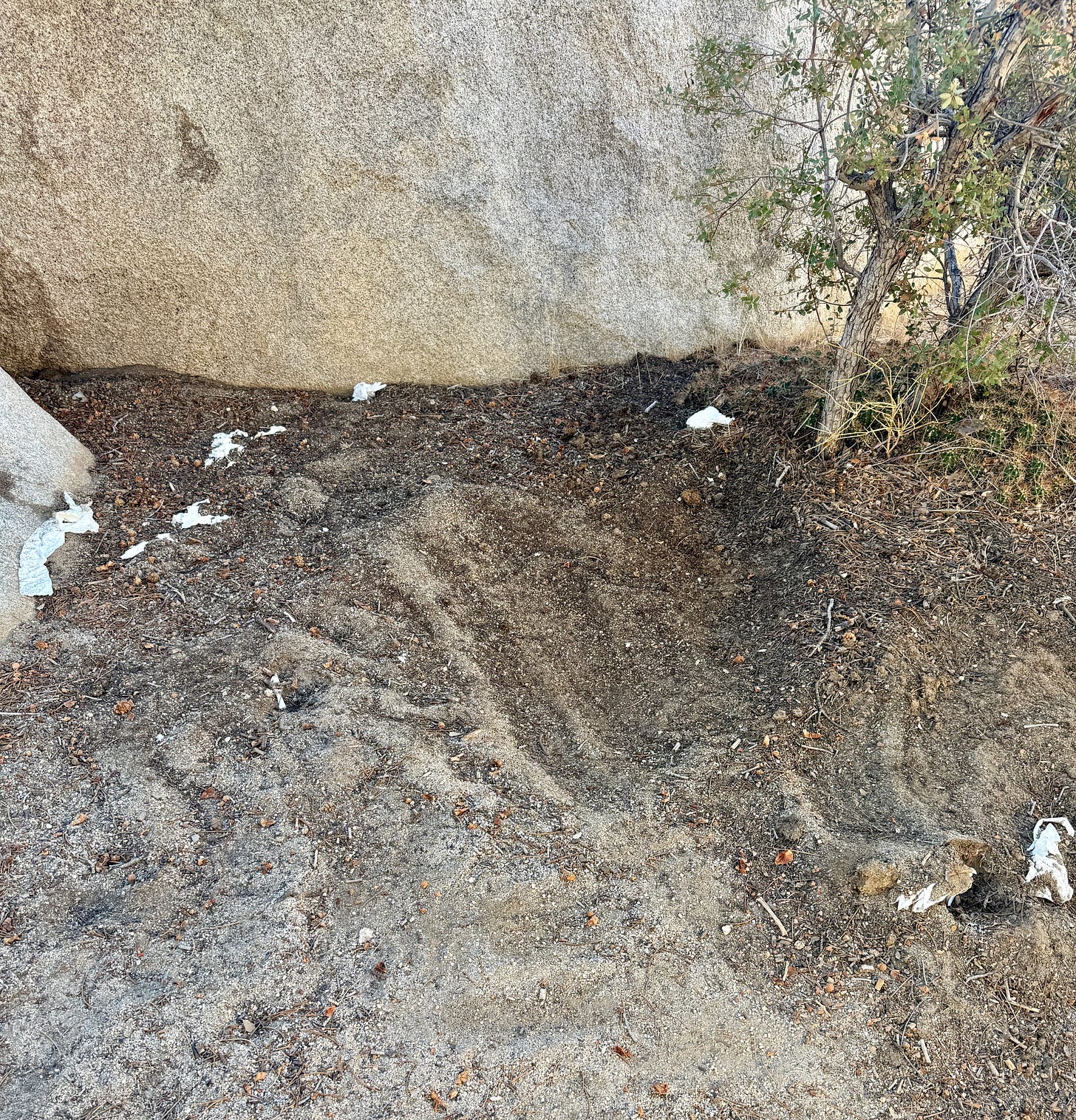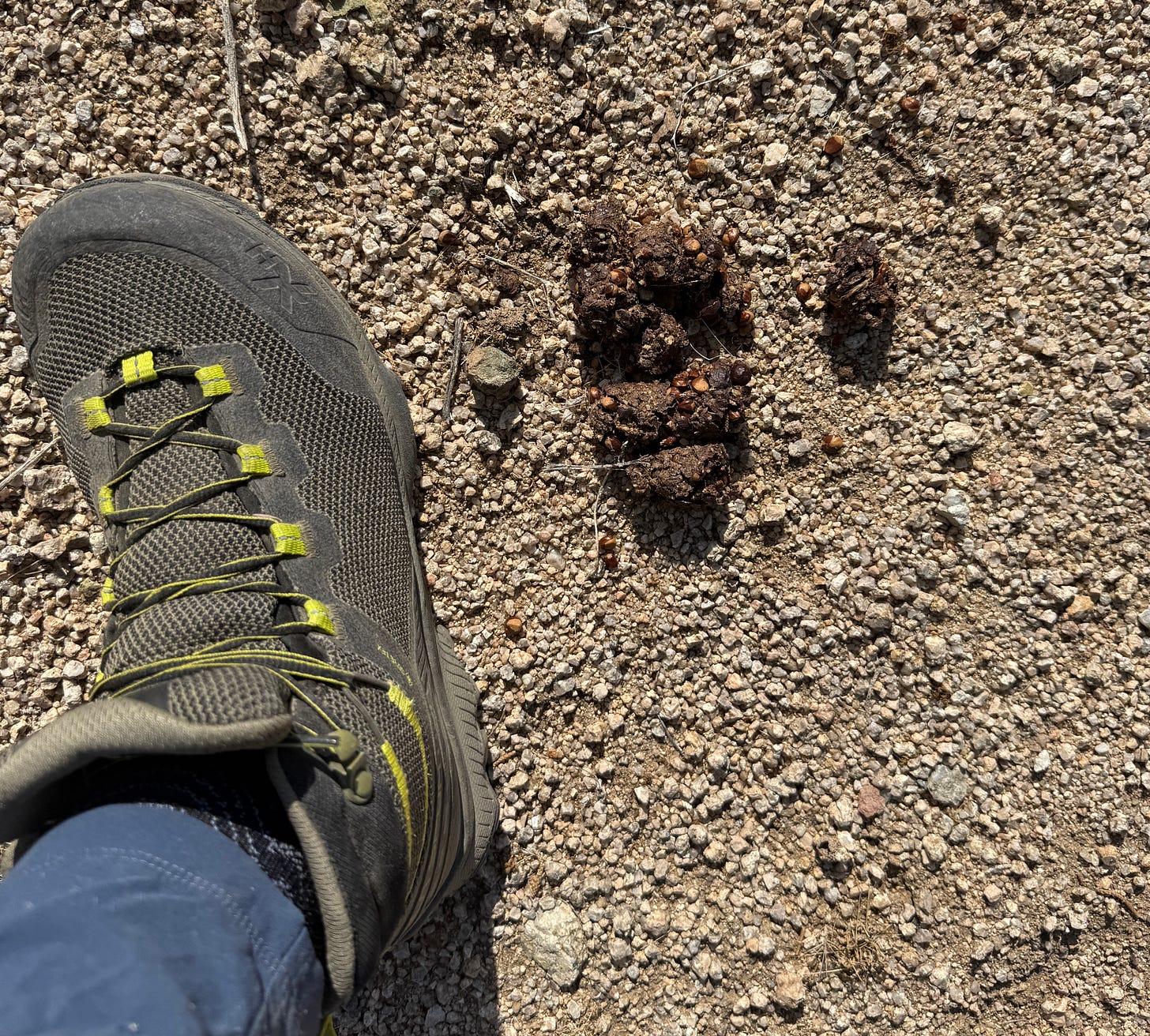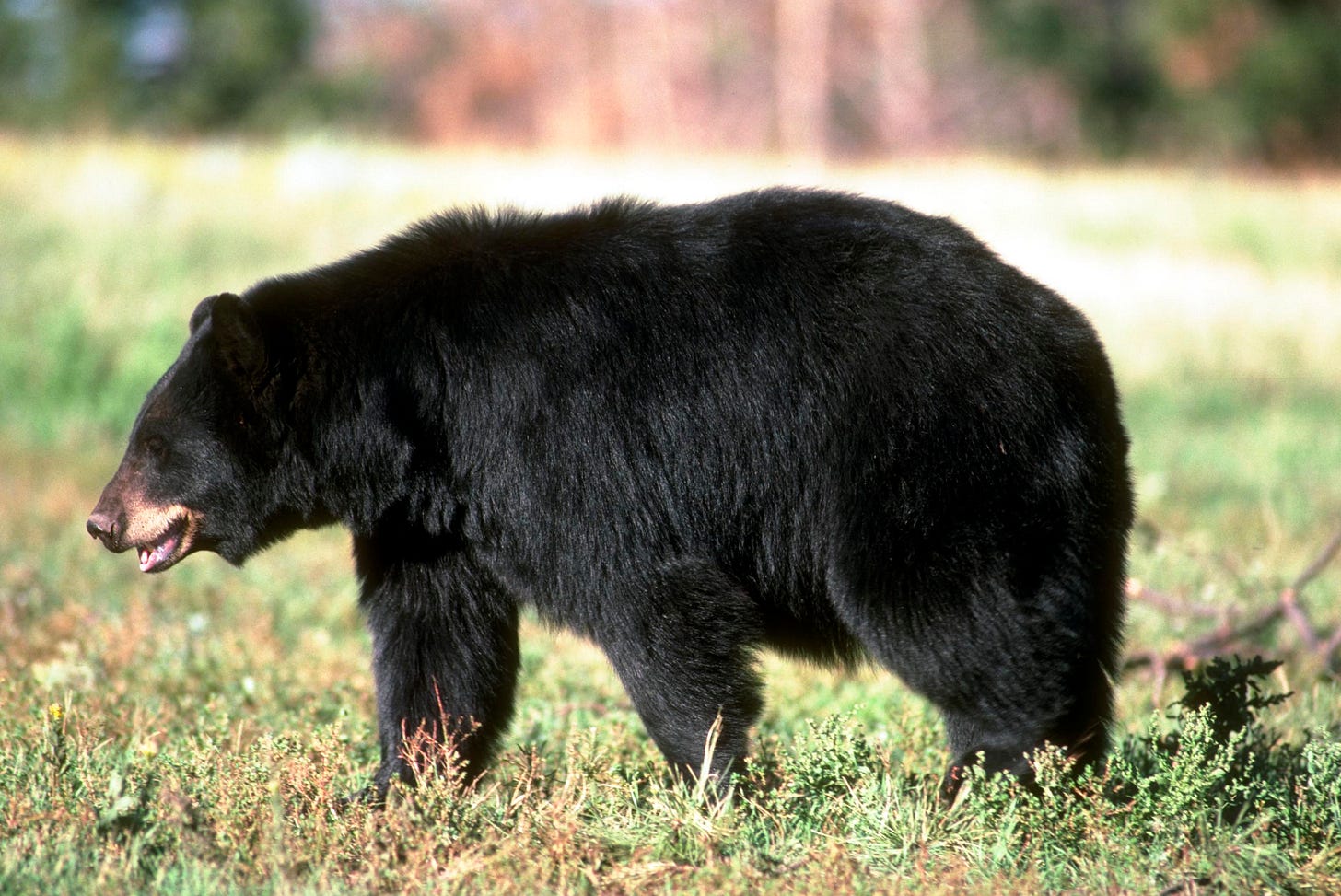Wildlife Wednesday: Bearly There
On scat, storms, and what moves unseen in the Mojave

The first sign was scat. Too big to be coyote poop. It sat loose and scattered near the Hidden Valley parking lot. I’ve seen bear scat before, not often, but enough to know.
Nearby, between two boulders, something had made itself comfortable. It dug a scrape and luxuriated in a roll of toilet paper.1 I stood there and asked myself: could a bear really be here, deep in the dry heart of Joshua Tree National Park?
Reading the News on the Ground
Summer hikes in Joshua Tree divide themselves. We get out early, beat the heat, rack up miles before the blast furnace flips to 11. Or they’re slow hikes reading the dispatches, letting the desert speak. News here comes in tracks, scat, seed husks, and subtle smells.
On slow hikes we stop to notice how ants cope, how a lizard flashes its tail like a warning flag, how the granite radiates heat sharp enough to scald a hand. Juniper berries cook on the branch until their gin-rich scent rises, pungent and spicy.2
One July, on a slow walk near Queen Mountain, we found more droppings. A bear had camped by a juniper exuberantly blue with berries, leaving copious plops in the sand wash. It had managed a feast, despite the month being drier than usual.
Video of a visitor sighting of a bear near Quail Mountain; starts at around 2:20
Bears live west of us, up in the San Bernardinos, where water and oaks and pine forests give them a steadier life. They range down toward Pioneertown and Big Morongo Canyon Preserve. They’re listed on the Joshua Tree National Park website as “uncommon migrants.” Still, uncommon doesn’t mean impossible.
I thought of the Eureka Fire that burned in May and June, the way flames and smoke push animals into strange directions. Maybe this bear, confused or driven by hunger, had come east, deeper into desert than usual. Bears can cover fifty miles in a week, following their noses, which are seven times more sensitive than a dog’s. A line of junipers, a trickle of wash, the faint smell of water or fruit, could pull a bear farther than we’d expect.
Waiting for Rain
But what struck me most wasn’t the surprise of the scat—it was the timing. July had passed dry as bone. No monsoon. I worried: how would a bear survive here?
Then, in August, cumulus clouds began to pile up on the eastern horizon. They looked like a line of fat, slow bears, reluctant to march this way. Day after day, they lingered. Teasing. Holding back their cargo of rain.
And then, one afternoon, they broke.
The first monsoon storms pelted Twentynine Palms. Flash floods scoured washes. Roads turned to rivers. Rushing water stranded drivers. The desert does not take rain gently.
But oh, the renewal. Creosote leaves brightened. Ocotillo greened up. The air itself smelled electric, sharp with ozone, sweet with that desert rain smell of tar, cinnamon, and rock.
I imagined the bear, wherever it had wandered, standing in the downpour, fur slicked flat, lapping rain pooled in granite hollows. A creature both out of place and perfectly at home.
Here in the Morongo Basin, sightings aren’t as rare as they once were. Just this summer, social media brimmed with stories and security camera videos: bears raiding trailers, pawing at backyard fruit trees, tipping trash cans, even breaking into cars. One hiker near Mission Creek Preserve fled after a close encounter and had to be rescued.
But black bears, despite their size, don’t want trouble. They want calories.
The Bigger Picture: Roads and Corridors
Whether this summer’s bear stays or moves on, the larger story is about movement. Animals cross landscapes constantly, and our highways are often the deadliest barriers.
On State Route 62, the Mojave Desert Land Trust documented 232 wildlife deaths in just over a year: mule deer, bighorn sheep, bobcat, coyote, fox, mountain lion, and yes, black bear.
Traffic on SR-62 has soared alongside park visitation and Basin population. Wildlife crossings—dedicated overpasses or underpasses—can cut these collisions by up to 90%.
The Land Trust, with partners like Caltrans, the Coachella Valley Conservation Commission, and others, is now applying for funding to plan two crossings at the Morongo and Yucca grades. These stretches are complete barriers; no safe passages exist for wildlife.
They’ll also knit together the habitats of Joshua Tree National Park, Sand to Snow National Monument, and the San Bernardinos. For bears, it could mean safer wanderings, fewer roadside carcasses, more nights spent under junipers with bellies full of berries.
Cloud Bears
When the desert sky builds clouds, it’s like watching mountains form. They darken, flash with lightning, and break open with water that can both destroy and restore.
The bear scat we’ve seen in the park is a reminder that other lives move through this landscape, quietly, mostly unseen.
Clouds carry stories of how animals like bears thread their way across ranges, down canyons, through highways and fire scars, seeking food and shelter.
Rain is their reprieve. Rain is ours, too.
Wherever that bear is now—back toward the mountains, or lingering among the junipers—I hope it found relief in the monsoon rain. I hope it stays elusive. And I hope we keep learning how to live alongside creatures who remind us that the desert still holds surprises.
A newspaper article in the 2010s mentions a bear sighting in Twentynine Palms, and if you know about this, please drop a note in the comments!
Leave your thoughts in the comments below. Please note that we do not allow anonymous comments. Please be sure your first and last name is on your profile prior to commenting. Anonymous comments will be deleted.
Feel free to share this article!
Help us reach our 2025 goal of $10,000 in subscriptions! Upgrade to a paid subscription for just $5 per month or $50 per year.
Would you care to donate more than $100? Our Paypal account is up and running!
Insert Charmin’ joke here.
I think juniper berries smell best in the snow. What do you think?





A beautiful piece on a beautiful animal and our magnificent desert.
Last month in ‘The Desert Trail’ news it was reported that evidence 🐾💩 of a Black Bear had been repeatedly found on “so-and-so’s” property out here in Desert Heights. Although the bear itself had not been seen.